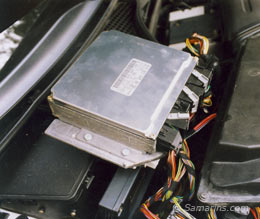Why my Check Engine light comes on?

The engine computer or ECM
|
The vehicle computer system has self-testing capability. When the computer senses that there is a problem with some of the components it stores the correspondent trouble code(s) in its memory and lights up the "Check Engine" or "Service Engine Soon" light to tell you that there is a problem and your car needs to be looked at. To properly diagnose what is wrong, you need to take your car to a mechanic or a dealer. The technician at the dealership or a garage will then hook up the scanner to the car computer and retrieve the stored trouble code(s). Then he (she) will look it up in the service manual provided by a car manufacturer. The service manual contains the list of possible codes (about few hundreds) and describes what each code means and what needs to be tested. The code itself doesn't tell exactly what component is defective - it only indicates where to look, what engine parameter is out of normal range. The technician will have to perform further testing to pinpoint a defective part.
Here is how this works
No comments:
Post a Comment